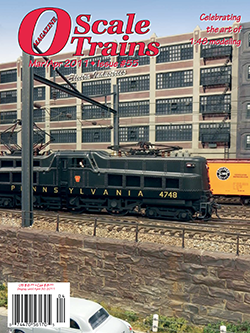 By Bruce Dombey/photos by the author
By Bruce Dombey/photos by the author
A small corner of my On30 layout models a heavy industry, one that handles palletized material. For years I have searched for a 1940s vintage forklift in O Scale to no avail. Then about a year ago I found a modern 1:43 forklift at a show and thought it had enough “vintage” features that I could backdate it. The model in question is a Welly diecast forklift model #9797 as seen in Photo 1. (These can be found on eBay quite easily. —Ed.)

I did not work from plans but, after forty years of working in heavy industry, I had a vision of what my finished forklift would look like. First I disassembled the model completely and began work on the body. I cut two pieces of 0.030” thick styrene, one 1’0” x 4’3” and the other 2’0” x 4’3”. When glued together they form the firewall between the engine compartment and the operator, and a platform for the engine (See Photo 2). I trimmed and sanded the engine platform to match the sides of the forklift body using a small machinist square to check my progress. Once it was shaped properly, I glued a shim under the platform to keep it level and then cemented the unit in place.

Next I cut a piece of 0.010” thick styrene to the shape shown in Figure 1 and Photo 2. This is a wrapper that will form the back of the new forklift body. I set the body flat on the work surface and placed the wrapper against it. I wrapped the styrene around the body, cementing as I went and glued the top of the wrapper to the engine platform/firewall. For added definition I glued a 0.010” x 0.060” styrene strip around the top of the engine compartment and another 0.010” x 0.1875” strip at the belt line. These can be seen in Photo 3.

A new dashboard was needed and I started with a piece of 0.020” styrene sheet cut 2’0” x 3’3” and framed it with 0.020” x 0.100” strip. I added another 0.010” x 0.060” strip around the base (See Photo 4). The steering column is 0.062” diameter styrene rod drilled to accept a common straight pin and glued to the dashboard. Flanking the column are two 0.125” dia. disks punched from 0.030” styrene to represent the gauges.

The original steering wheel was too small. I made a new wheel by removing half the spokes from an O Scale brake wheel and drilled it to take a straight pin. The shift lever is made from another straight pin with a large round head.
The fuel tank seen in Photo 4 was made from 0.218” (7/32) dia. styrene tubing cut 1’6” long. The ends were made from 0.030” styrene sheet using a 0.1875” (3/16) hole punch. The cap was made using a 0.125” (1/8) hole punch. The hold down straps are 0.010” x 0.060” styrene.

The engine is an HO Scale casting made by Life-Like, part # 1659, Power Generator. I removed the unit from its frame and cut off the fan and the crankcase. After I relocated the air cleaner, the unit was ready to be cemented to the engine platform. I reused the exhaust pipe by slipping it into a piece of 0.156” (5/32) tubing to represent the muffler.

The chassis required some work as well. I removed one front wheel to shorten the axle so that when reassembled the wheels would fit tight against the frame. I also removed the rear wheels and axle so I could deepen the notches in the frame that would allow the rear wheels to fit inside the new body wrapper.

I added a few nut-bolt-washer castings to the lift assembly and using scrap styrene rod and strip I fabricated a lift drive. The drive is a double-ended motor with pinions that drive the racks on the lift. All of the parts and pieces prior to final assembly can be seen in Photo 5.

I brush paint all of my models using Polly Scale acrylic paints. I painted the entire forklift body Olive Drab. The fork assembly, engine exhaust and wheels were painted Roof Brown. I used Grimy Black for the tires, seat, floor mat and steering wheel. The “CASE” dry transfer is a Woodland Scenics item. Finally I view the finish a model receives as another detail, so I brushed a generous amount of tan chalk over every-thing because a variegated surface always looks more realistic (Photos 6 and 7).


